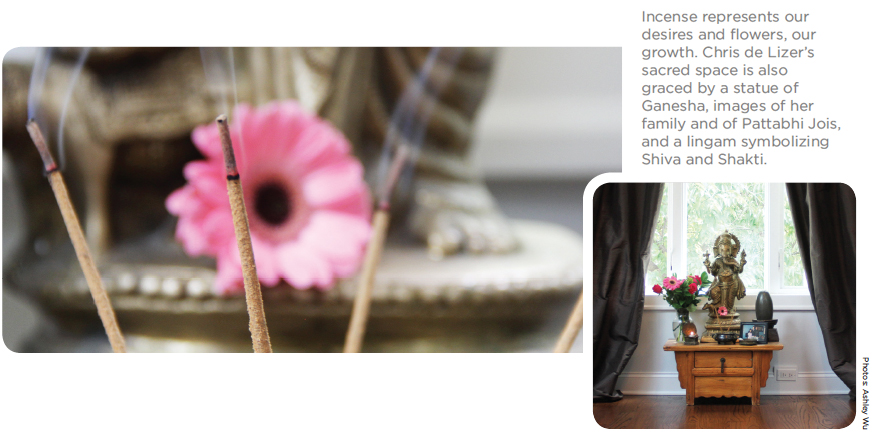By Chris de Lizer
I love when I go to a yoga studio and before class, the teacher lights a candle or incense. Or, maybe a student brings a flower from his or her garden, or class starts with a simple, collective “Aum.” In each example, consciously or not, we are making an offering to our higher power and expressing love and gratitude. The quiet space allows us to find stillness and clarity in our lives.
For millennia, followers of various traditions have created altars as places of worship, prayer, reflection and meditation. You may already have an altar in your home but may not consider it as such. Do you have a place where you keep family photographs and mementos? Do you feel reverence and devotion when you pass by or look at your space?
The purpose of your altar can be healing, devotional or anything else of personal significance. The design of your altar can be as simple or as elegant as you wish. Creating your altar is as easy as 1, 2, 3.
1) Clear a space
First, designate a space for your altar where you will create ritual. Choose an area that is quiet, clean and not too busy. The space can be anywhere—in your home, garden or office. It could be a room, a corner of a room, a table, a bookshelf or even a closet.
2) Select meaningful items
To embellish your altar and stimulate emotion, choose items that represent your spiritual path. Each item may appear ordinary, but is personally significant and symbolizes an important experience or memory. Photographs may be used to evoke feelings of love, reverence and friendship.
3) Arrange your objects in a visually pleasing way
To curate your altar, place its largest object in the center. The focal point of my personal altar (above, right) is a brass statue of Ganesha, the Hindu Lord and remover of obstacles. Then, work outwards. There is no right way or wrong way to appoint your altar, but do keep it clean and uncluttered.
You might make an offering of flowers, which represent the good in us that has blossomed. An offering of fruit symbolizes self-sacrifice and surrender. Incense represents our desires. Candles represent divine presence and wisdom and also symbolize the light within that we offer to the absolute.
The altar symbolizes a separation between the everyday and the spiritual. Your altar, a place of peace and stillness, is a sacred space to commune with your higher source and self-reflect. Begin a daily practice sitting quietly in front of your altar. Feel inspired and calm. The more time you spend in front of your altar, the more sacred the space becomes.























No Responses to “Three steps to create a home altar”